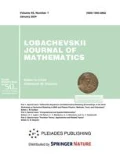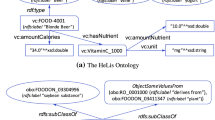Abstract
The paper addresses the issue of filling the gaps in the semantic library based on the distributional semantics of the terms of its thesaurus and the ontology relations. The goal of the study is to fully reflect the actual structure of relations between mathematical subject domains. This is done through identifying context-sensitive semantic relations, and with the use of an algorithm that is based on the word2vec feedforward neural networks. The understanding of the query is analyzed after preliminary processing of set of articles and metadata saturation. The proposed procedure helps to improve the work with the full-text index and, as a result, improves the quality of search in the library. Using a full-text index of a digital semantic library as an example, we demonstrate the process of filling gaps by saturating the semantic relations of the ontology of mathematical subject domains.

Similar content being viewed by others
REFERENCES
D. Oberle, N. Guarino, and S. Staab, ‘‘What is an ontology?,’’ in Handbook on Ontologies, Ed. by S. Staab (Springer, Berlin, 2009).
Y. Zagorulko, O. Borovikova, and G. Zagorulko, ‘‘Development of ontologies of scientific subject domains using ontology design patterns,’’ Commun. Comput. Inform. Sci. 822, 141–156 (2018). https://doi.org/10.1007/978-3-319-96553-6-11
A. B. Antopol’skij, N. E. Kalenov, V. A. Serebryakov, and A. N. Sotnikov, ‘‘Common digital space of scientific knowledge,’’ Vestn. Ross. Akad. Nauk 89, 728–735 (2019). https://doi.org/10.31857/S0869-5873897728-735
GOST (State Standard) No. 15971-90, Information processing systems, Terms and definitions. http://docs.cntd.ru/document/gost-15971-90. Accessed 2021.
GOST (State Standard) No. P 7.0.91-2015, ISO 25964-1:2011, System of standards on information, librarianship and publishing. Thesauri for information retrieval. http://docs.cntd.ru/document/1200129056. Accessed 2021.
Yu. A. Shrejder, ‘‘Thesauri in computer science and theoretical semantics,’’ Nauch.-Tekh. Inform. 2 (3), 21–24 (1971).
V. C. Storey, ‘‘Understanding semantic relationships,’’ VLDB J. 2, 455–488 (1993). https://doi.org/10.1007/BF01263048
T. L. Teorey, D. Yang, and J. P. Fry, ‘‘A logical design methodology for relational databases using the extended entity-relationship model,’’ Comput. Surv. 18, 197–221 (1986).
D. Price, ‘‘Networks of scientific papers,’’ Science (Washington, DC, U. S.) 149 (3683), 510–515 (1965). https://doi.org/10.1126/science.149.3683.510
T. Mikolov, W. T. Yih, and C. Zweig, ‘‘Linguistic regularities in continuous space word representations,’’ in Proceedings of the 2013 Conference of the North American Chapter of the Association for Computational Linguistics: Human Language Technologies NAACL HLT, Atlanta, Georgia, June 9–14, 2013.
Q. Le and T. Mikolov, ‘‘Distributed representations of sentences and document,’’ in Proceedings of the International Conference on Machine Learning, 2014, pp. 1188–1196.
Z. Harris, ‘‘Distributional structure,’’ Word 10 (23), 146–162 (1954). https://doi.org/10.1080/00437956.1954.11659520
O. Ataeva, V. Serebryakov, and N. Tuchkova, ‘‘Ontological approach: Knowledge representation and knowledge extraction,’’ Lobachevskii J. Math. 41 (10), 1938–1948 (2020). https://doi.org/10.1134/S1995080220100030
O. Ataeva, V. Serebryakov, and N. Tuchkova, ‘‘Query expansion method application for searching in mathematical subject domains,’’ CEUR Workshop Proc. 2543, 38–48 (2020). http://ceur-ws.org/Vol-2543/rpaper04.pdf urn:nbn:de:0074-2543-4. Accessed 2021.
O. M. Ataeva, V. A. Serebryakov, and N. P. Tuchkova, ‘‘Mathematical physics branches: Identifying mixed type equations,’’ Lobachevskii J. Math. 40 (7), 876–886 (2019).
O. M. Ataeva, ‘‘LibMet semantic library information model,’’ Program. Produkty Sist. 4, 36–44 (2016).
C. Wang, L. Cao, and B. Zhou, ‘‘IMedical synonym extraction with concept space models,’’ in Proceedings of the 24th International Conference on Artificial Intelligence, IJCAI’15 (2015), pp. 989–995.
I. K. Polozov and I. A. Volkova, ‘‘Application of Word2vec technology in the task of selecting tonality inverters,’’ Mezhdun. Nauch.-Issled. Zh. 4-1 (94), 36–39 (2020).
I. M. Vinogradov, Mathematical Encyclopedy (Sov. Entsiklopediya, Moscow, 1979) [in Russian].
Mathematical Encyclopedy. https://dic.academic.ru/contents.nsf/enc_mathematics. Accessed 2021.
Encyclopedy World. http://www.encyclopedia.ru. Accessed 2021.
S. Grimm, A. Abecker, J. Völker, and R. Studer, ‘‘Ontologies and the semantic web,’’ in Handbook of Semantic Web Technologies, Ed. by J. Domingue, D. Fensel, and J. A. Hendler (Springer, Berlin, 2011).
C. Klaussner and D. Zhekova, ‘‘Application of Word2vec technology in the task of selecting tonality inverters,’’ in Proceedings of the 2nd Student Research Workshop associated with RANLP, 2011, pp. 109–114.
M. M. K. Hlava, ‘‘The taxobook: History, theories, and concepts of knowledge organization, Part 1 of a 3-part series,’’ Synth. Lect. Inform. Concepts, Retrieval, Serv. 6 (3), 1–80 (2014).
M. M. K. Hlava, ‘‘The taxobook: Principles and practices of building taxonomies, part 2 of a 3-part series,’’ Synth. Lect. Inform. Concepts, Retrieval, Serv. 6 (4), 1–164 (2014).
M. M. K. Hlava, ‘‘The taxobook: Applications, implementation, and integration in search, Part 3 of a 3-part series,’’ Synth. Lect. Inform. Concepts, Retrieval, Serv. 6 (4), 1–56 (2014).
C. D. Manning, P. Raghavan, and H. Schütze, Introduction to Information. Retrieval (Cambridge Univ. Press, Cambridge, 2008).
D. Allemang and J. Hendler, Semantic Web for the Working Ontologist: Effective Modeling in RDFS and OWL (Elsevier, Amsterdam, 2011).
Funding
This work was supported by budget topics of the Ministry of Science and Higher Education of the Russian Federation ‘‘Mathematical methods for data analysis and forecasting’’ and particular by the Russian Foundation for Basic Research, project no. 20-07-00324.
Author information
Authors and Affiliations
Corresponding authors
Additional information
(Submitted by A. M. Elizarov)
Rights and permissions
About this article
Cite this article
Ataeva, O.M., Serebryakov, V.A. & Tuchkova, N.P. Using Applied Ontology to Saturate Semantic Relations. Lobachevskii J Math 42, 1776–1785 (2021). https://doi.org/10.1134/S1995080221080059
Received:
Revised:
Accepted:
Published:
Issue Date:
DOI: https://doi.org/10.1134/S1995080221080059




